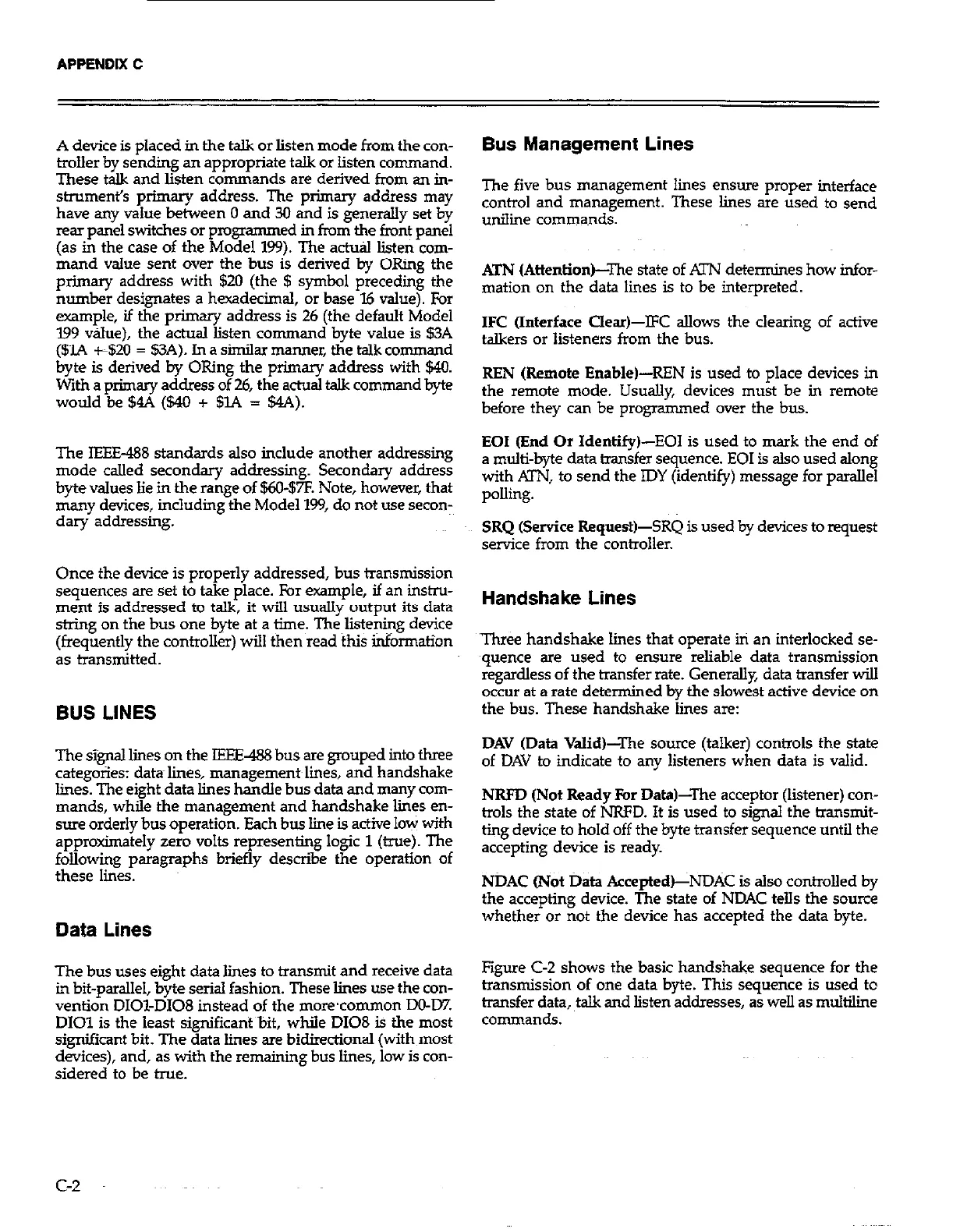APPENDIX C
A device is placed in the talk or listen mode from the con-
troller by sending an appropriate talk or listen command.
These talk and listen commands are derived from an in-
shument’s primary address. The primary address may
have any value between 0 and 30 and is generally set by
rear panel switches or pmgxmmed in from the front panel
(as in the case of the Model 1%). The actual listen com-
mand value sent over the bus is derived by ORing the
primary address with $20 (the $ symbol preceding the
number designates a hexadecimal, or base 16 value). For
-pie, if the primary address is 26 (the default Model
199 value), the actual listen command byte value is $3A
($lA 420 = S3A). In a similar manner, the talk command
byte is derived by ORing the primary address with $40.
With a primary address of 26, the ach~al talk command byte
would be %A ($40 + $lA = %A).
The IEEE-488 standards also include another addressing
mode called secondary addressing. Secondary address
byte values lie in the range of $60-$7F. Note, however, that
many devices, including the Model 199, do not use secon-
day addressing.
Once the device is properly addressed, bus transmission
sequences are set to take place. For example, if an instru-
ment is addressed to talk, it will usually output its data
string on the bus one byte at a time. The~listening device
(frequently the controller) will then read this information
as transmitted.
BUS LINES
The signal lines on the IEEE488 bus are grouped into three
categories: data~lines, management~lines, and handshake
lines. The eight data lines handle bus data and many com-
mands, while the management and handshake lies en-
sure orderly bus operation. Each bus line is active low with
approximately zero volts representing logic 1 (true). The
following paragraphs briefly describe the operation of
these lines.
Data Lines
The bus uses eight data lines to transmit and receive data
in bit-parallel, byte serial fashion. These lines use the con-
vention DIOI-DI08 instead of the more’common DO-W.
DIOl is the least significant bit, while DI08 is the most
significant bit. The data lines are bidirectional (with most
devices), and, as with the remaining bus lines, low is con-
sidered to be true.
Bus Management Lines
The five bus management lines ensure proper interface
control and management. These lines are used to send
uniline commands.
ATN (Attention&The state of ATN determines how infor-
mation on the data lines is to be interpreted.
IFC (Interface Clear)-IFC allows the clearing of active
talkers or listeners from the bus.
REN (Remote Enable)-REN is used to place devices in
the remote mode. Usually, devices must be in remote
before they can be programmed over the bus.
EOI (End Or IdentifykEOI is used to mark the end of
a multi-byte data transfer sequence. EOI is also used along
with ATN, to send the IDY (identify) message for parallel
polling.
SRQ (Service Request)-SRQ is used by devices to request
service from the controller.
Handshake Lines
‘Three handshake lines that operate ixi an interlocked se-
quence are used to ensure reliable data transmission
regardless of the transfer rate. Generally, data transfer will
occur at a rate determined by the slowest active device on
the bus. These handshake lines are:
DAV (Data Valid)-The source (talker) controls the state
of DAV to indicate to any listeners when data is valid.
NRFD (Not Ready fir D&al--The acceptor (listener) con-
trols the state of NRFD. It is used to signal the transmit-
ting device to hold off the byte transfer sequence until the
accepting device is ready.
NDAC (Not Bata Accepted&ND& is also controlled by
the accepting device. The state of NDAC tells the source
whether or not the device has accepted the data byte.
Figure C-Z shows the basic handshake sequence for the
transmission of one data byte. This sequence is used to
transfer data, talk and listen addresses, as weU as multiliie
commands.
c-2
